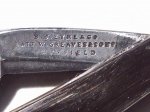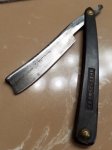drmoss_ca
Is there a Doctor in the house ?
I'm dredging up the dregs from the basement and came across a razor I'm ashamed to say I don't recall. Horn scales with no bullseye washers, square point, full hollow, concave spine, constant width blade, rather short tang, with a cut-out on the shank, which has a double stabiliser:

and the shank itself is where it gets interesting:

"B.J.EYRE & CO
AT E W.GREAVES & SONS
SHEFFIELD"
First thing is the extraneous 'E' - maybe William Greaves had an unused first name? Or is the "ATE" preceded by another letter that has worn off? We know Benjamin James Eyre was a partner at Greaves' Sheaf Works until it's dissolution in 1850, and then traded as Eyre, Ward & Co. using the Sheaf Works, and after 1857, Eyre traded alone as B.J.Eyre & Co. I had guessed from the anatomy of this razor it was 1840 - 1850, so I think it comes from Eyre's original participation at Sheaf Works somewhere before 1850.
Given its interesting nature, I think I'll hone this one for use after the Dovo seven day set, and before the eleven Friodurs waiting impatiently, along with a couple of others. I have thrown out two chipped blades that are beyond rescue, but find I have six more that were given to me and are intact but filthy. Anyone want six razors to play at restoration with?

and the shank itself is where it gets interesting:

"B.J.EYRE & CO
AT E W.GREAVES & SONS
SHEFFIELD"
First thing is the extraneous 'E' - maybe William Greaves had an unused first name? Or is the "ATE" preceded by another letter that has worn off? We know Benjamin James Eyre was a partner at Greaves' Sheaf Works until it's dissolution in 1850, and then traded as Eyre, Ward & Co. using the Sheaf Works, and after 1857, Eyre traded alone as B.J.Eyre & Co. I had guessed from the anatomy of this razor it was 1840 - 1850, so I think it comes from Eyre's original participation at Sheaf Works somewhere before 1850.
Given its interesting nature, I think I'll hone this one for use after the Dovo seven day set, and before the eleven Friodurs waiting impatiently, along with a couple of others. I have thrown out two chipped blades that are beyond rescue, but find I have six more that were given to me and are intact but filthy. Anyone want six razors to play at restoration with?





